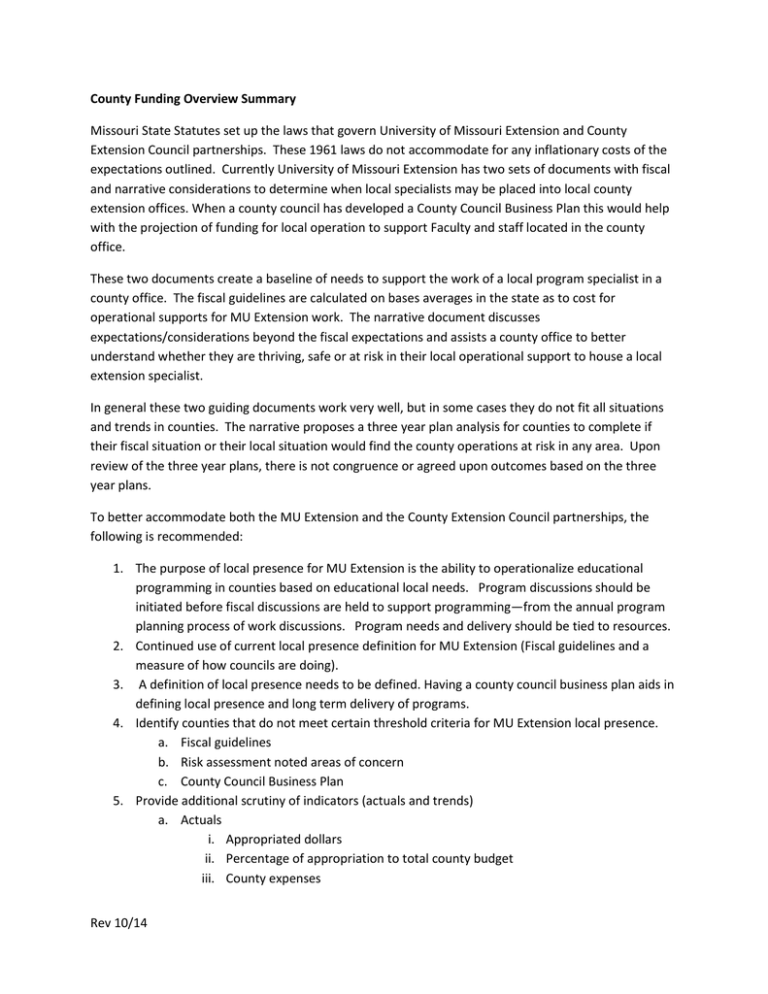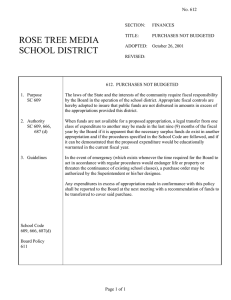Missouri State Statutes set up the laws that govern University... Extension Council partnerships. These 1961 laws do not accommodate... County Funding Overview Summary
advertisement

County Funding Overview Summary Missouri State Statutes set up the laws that govern University of Missouri Extension and County Extension Council partnerships. These 1961 laws do not accommodate for any inflationary costs of the expectations outlined. Currently University of Missouri Extension has two sets of documents with fiscal and narrative considerations to determine when local specialists may be placed into local county extension offices. When a county council has developed a County Council Business Plan this would help with the projection of funding for local operation to support Faculty and staff located in the county office. These two documents create a baseline of needs to support the work of a local program specialist in a county office. The fiscal guidelines are calculated on bases averages in the state as to cost for operational supports for MU Extension work. The narrative document discusses expectations/considerations beyond the fiscal expectations and assists a county office to better understand whether they are thriving, safe or at risk in their local operational support to house a local extension specialist. In general these two guiding documents work very well, but in some cases they do not fit all situations and trends in counties. The narrative proposes a three year plan analysis for counties to complete if their fiscal situation or their local situation would find the county operations at risk in any area. Upon review of the three year plans, there is not congruence or agreed upon outcomes based on the three year plans. To better accommodate both the MU Extension and the County Extension Council partnerships, the following is recommended: 1. The purpose of local presence for MU Extension is the ability to operationalize educational programming in counties based on educational local needs. Program discussions should be initiated before fiscal discussions are held to support programming—from the annual program planning process of work discussions. Program needs and delivery should be tied to resources. 2. Continued use of current local presence definition for MU Extension (Fiscal guidelines and a measure of how councils are doing). 3. A definition of local presence needs to be defined. Having a county council business plan aids in defining local presence and long term delivery of programs. 4. Identify counties that do not meet certain threshold criteria for MU Extension local presence. a. Fiscal guidelines b. Risk assessment noted areas of concern c. County Council Business Plan 5. Provide additional scrutiny of indicators (actuals and trends) a. Actuals i. Appropriated dollars ii. Percentage of appropriation to total county budget iii. County expenses Rev 10/14 6. 7. 8. 9. iv. Revenue generated by the local office v. Ratio of what revenues the county receives and that they provide for Extension (percentage of mil) b. Trends i. Ability to maintain faculty and staff in office at current level of appropriation and revenue generation…..is the current trend sustainable for faculty and staff assigned to office? ii. What ability does the county have to appropriate on-going dollars for local operations? iii. Office hours iv. Local secretarial support v. Has local visibility (physical office environment) improved or decreased Additional discussion points for councils and MU Extension: a. # of positions to be housed a location b. Should office be co-located with other agencies or another county extension operation c. Potential for county sharing of resources with other counties or district option. d. What other sustainable sources of revenue should be included in budget discussions? e. County office facilities are important sources of in-kind, but they do not pay for operational supports of travel, secretarial support, office hours, etc. Use of the written and adopted county business plan as a means for discussion and agreement between MU Extension (Regional Directors) and local county councils to plan for appropriate Extension local presence in a county when fiscal guidelines are not met. Current three year plans fall short of providing a pathway for action to increase funds on a specific timeline or how goals must be met. The business plan should be written and agreed upon by both MU Extension (appropriate Regional Director) and the County Extension Council. The business plan template is available on the Share drive. a. Business Plans: i. Should include local process for improving overall operational support for positions ii. Should include MU commitments for position placement in the county given the overall funding status iii. Should include specific dollar goals and timeline to meet goals, with annual benchmarks and specific plans for each entity not meeting benchmarks. iv. The business plan should be filed by the county with the Regional Director by April 1, who then must submit these business plans to Associate Vice Provost and Associate Director of MU Extension and County Council Coordinator by June 1 annually Support for a county in writing a business plan is available from the County Council Coordinator, Regional Director A critical part of the county council business plan is the endowment funding. This section can be support in many ways by having MU Extension Donor Education Director or Director of Rev 10/14 Advancement meet with the council to share best practices and a process to increase endowment funds. 10. The County Council Business Plan template is attached and part of county funding guidance. 11. Business plans of counties not meeting the threshold criteria described under #4 will be reviewed by an oversight committee for statewide consistency and best practices in how counties and MU Extension handle local funding issues and staffing of program faculty and staff. The oversight committee will be made up of two members from the Extension State Council, two county program directors, two faculty, and a representative from Extension administrative management office (the group that determines the fiscal guidelines annually), convened and chaired by the County Council Coordinator. Business plans will be reviewed June-September with any recommendations for Extension Councils ready by September 1. Revised October 28, 2014 Rev 10/14

